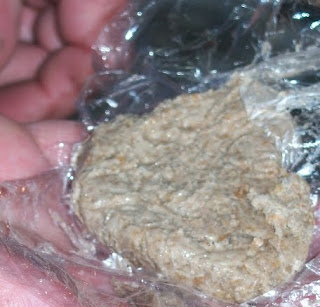

It was a bright, hot, dry July day when we went to visit Robyn Wyman at Full Bloom Farms. http://www.fullbloomfarm.ca/
 Our purpose was to get the Lavender for our first foray into making hydrosols. We’d bought a still in April, three months before, and had waited in anticipation for the Lavender to be ready.
Our purpose was to get the Lavender for our first foray into making hydrosols. We’d bought a still in April, three months before, and had waited in anticipation for the Lavender to be ready.

The day before, I’d purchased 3-four litre jugs of pure water and had sterilized two dozen canning jars.


We purchased five pounds of organic Hidecote and Munstead Lavender (Lavendula angustifolia)
We were able to stuff about three pounds of it into the cylinder and the onion. The rest we dried; and I am tincturing some of it into alcohol.
We'd bought a 10 Litre Copper Alembic from the Essential Oil Company in Oregon, when we were heading to the coast in April. All hooked up, it is truly a work of art.
The column goes on the boiler and the onion goes on top of that. The copper tube between the onion and the condenser, known as a 'bird's beak', conducts the condensate into the condenser. Cooling water is connected to the top of the condenser vessel through a tube from behind. This water runs around the outside of the coil and leaves via a drain at the bottom front; it is then drained into a collecting tub and is re-circulated back up to the condenser using an aquarium pump. This reservoir needs the water changed periodically to keep it cool.
Norm set it up in his shop. We'd purchased a hot plate to boil the water. We placed 10 Litres of pure water in the boiler, stuffed the column and onion, and connected those with a traditional rye flour paste. We had a sterile, covered, collecting pail in which to gather the hydrosol.



 Our whole house and yard smelled like Lavender. We had the grandkids over for the weekend and they loved the smell and were fascinated by the process. They each went home with a gold organza bag stuffed with lavender. They slept better than usual that night.
Our whole house and yard smelled like Lavender. We had the grandkids over for the weekend and they loved the smell and were fascinated by the process. They each went home with a gold organza bag stuffed with lavender. They slept better than usual that night. The essential oil was completely inhabiting the hydrosol so we were not able to collect any on its own. The sterile flower water was collected into a sterile vessel and transferred into sterile jars so it is suitable for cooking and cosmetic use. I keep mine in the fridge. I had a half-jar that I've used as a control. It has been sitting on our bathroom countertop for two months, as I use it every day, and still smells fresh and bright.
The essential oil was completely inhabiting the hydrosol so we were not able to collect any on its own. The sterile flower water was collected into a sterile vessel and transferred into sterile jars so it is suitable for cooking and cosmetic use. I keep mine in the fridge. I had a half-jar that I've used as a control. It has been sitting on our bathroom countertop for two months, as I use it every day, and still smells fresh and bright.Our Lavender hydrosol is wonderfully fragrant, clear, and very healing.
Properties include:
`balancing so ideal for combination skin
`use as a facial toner
`use in combination with helichrysum and other hydrosols for bangs, burns, bugs, and bashes
`calming to the heart and mind - use as a spray to walk through
`add to cosmetic cream as part of the water portion
`use as a linen spray
`spray the kids/babies beds
`spray in front of the kids and get them to walk through the mist
`add some essential oils and make a body spray - shake well before use
`spray on sunburn
`wound healing, promoting tissue regeneration
`antiseptic, antibacterial, and anti-imflammatory
2 oz blue cobalt bottle for $18.00 Canadian plus shipping and handling direct to you. Please email me with your location so I can find out what shipping will be and send you a PayPal Invoice. Thank you. LynAyre@telus.net







.JPG)
.JPG)
.JPG)
.JPG)
.JPG)










